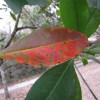Abstract
Bay trees in Florida can be difficult to distinguish because their leaves all look alike at first glance. The leaves of bays are all simple, large, elliptical, and evergreen. In addition, several bay species grow in overlapping ranges and habitats. Many times, two or more different species of bay will be found growing right next to one other. This 7-page fact sheet includes a dichotomous key to help in the identification of common bay trees found in Florida. A basic description and photos of each species help with the identification process. Written by Lynn Proenza and Michael Andreu and published by the UF Department of School of Forest Resources and Conservation, September 2013.
References
Cook, Will. 2011. Trees, Shrubs, and Woody Vines of North Carolina [online]. Duke University. Accessed: January 19, 2012. Available: http://www.duke.edu/~cwcook/trees/
eFloras. 2008. Published on the Internet http://www.efloras. org [accessed July 11, 2011 – August 22, 2011]. Missouri Botanical Garden, St. Louis, MO & Harvard University Herbaria, Cambridge, MA.
Godfrey, Robert K. 1988. Trees, Shrubs, and Woody Vines of Northern Florida and Adjacent Georgia and Alabama. Athens, Georgia: University of Georgia Press.
Hall, David W. 1993. Illustrated Plants of Florida and the Coastal Plain. Maupin House, Gainesville, Florida.
Nelson, Gil. 1994. The Trees of Florida. Sarasota, Florida: Pineapple Press Inc.
Van Deelen, Timothy R. 1991. “Persea borbonia.” In: Fire Effects Information System, [Online]. U.S. Department of Agriculture, Forest Service, Rocky Mountain Research Station, Fire Sciences Laboratory (Producer). Available: http://www.fs.fed.us/database/feis/ [2012, January 19].
Unless otherwise specified, articles published in the EDIS journal after January 1, 2024 are licensed under a Creative Commons Attribution-NonCommercial-NoDerivs 4.0 International (CC BY-NC-ND 4.0) license.

